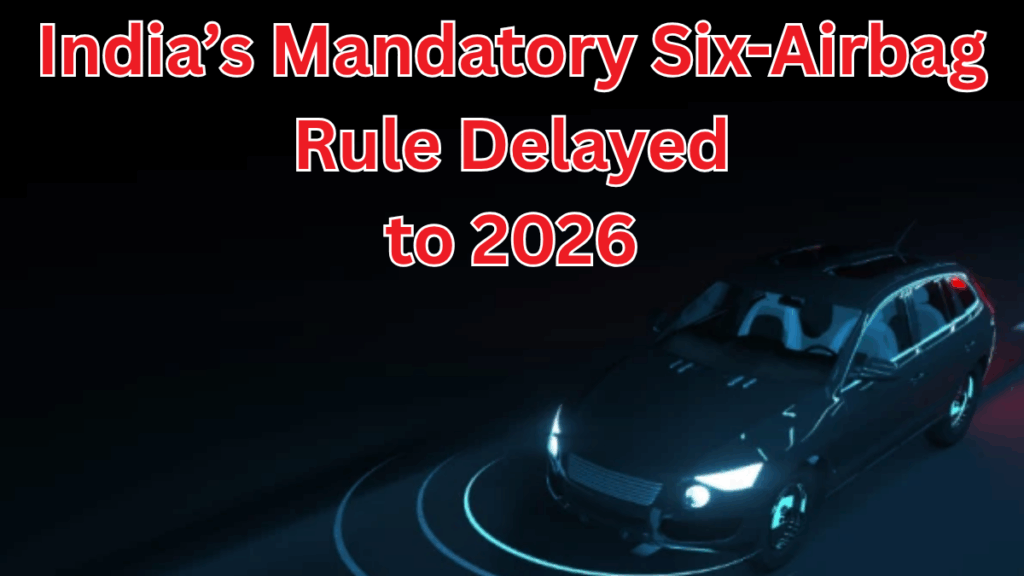The Indian automotive industry and safety-conscious consumers were gearing up for a significant upgrade in vehicle safety standards — the introduction of mandatory six airbags in new cars. However, recent MoRTH updates have revealed a delay, pushing this crucial regulation back to 2026. Let’s dive into why the India airbag rule is postponed and what this means for car manufacturing and vehicle safety standards in the country.

What is the Six-Airbag Rule?
The six-airbag mandate was set to be a game-changer in road safety. It requires new vehicles to be equipped with:
-
Driver and passenger front airbags
-
Side airbags for front occupants
-
Curtain airbags for both rows
This regulation aims to minimize injuries during accidents by offering comprehensive protection inside the vehicle cabin.
Why Has the India Airbag Rule Been Delayed?
The Ministry of Road Transport and Highways (MoRTH) announced the postponement citing several reasons:
-
Supply Chain Challenges: The global shortage of semiconductor chips and airbag components has hampered manufacturers’ ability to comply.
-
Cost Impact on Car Prices: Adding six airbags significantly raises manufacturing costs, which would reflect in higher car prices — a concern in a price-sensitive market.
-
Time Needed for Compliance: Car manufacturers have requested more time to upgrade their production lines and ensure quality safety standards.
-
Focus on Comprehensive Vehicle Safety: MoRTH is taking a holistic approach, balancing airbags with other vehicle safety standards like ABS, ESC, and crash test ratings.
What Does This Mean for Car Manufacturing in India?
Delaying the India airbag rule provides carmakers some breathing room but also brings challenges:
| Aspect | Impact of Delay | Outlook |
|---|---|---|
| Manufacturers | More time to adapt production processes | Better quality control and innovation |
| Consumers | Continued availability of affordable cars | Slower access to advanced airbag protection |
| Safety Advocacy Groups | Concern over slower safety improvements | Push for stricter enforcement in future |
| Regulatory Authorities | Need to monitor progress closely | Potential updates on other safety norms |
How Will Vehicle Safety Standards Evolve?
While airbags are vital, the delay has intensified focus on integrating a broad spectrum of safety features, including:
-
Anti-lock Braking Systems (ABS)
-
Electronic Stability Control (ESC)
-
Enhanced crash test protocols
-
Seatbelt reminders and child safety locks
The overall goal is to bring Indian vehicles up to global safety benchmarks progressively.
Key Takeaways
-
The mandatory six-airbag rule in India is now scheduled to be enforced starting 2026, not earlier.
-
The delay stems from industry challenges, cost concerns, and the need for quality assurance.
-
MoRTH updates highlight a phased approach, focusing on overall vehicle safety standards beyond airbags.
-
The decision affects both car manufacturing timelines and consumer safety expectations.
FAQs
Q1: What exactly is the India airbag rule about?
The rule mandates that all new cars sold in India must have six airbags by 2026 to enhance passenger safety during collisions.
Q2: Why did MoRTH delay the implementation of this rule?
The delay is mainly due to supply chain issues, the increased cost burden on manufacturers, and the need for more time to comply without compromising safety quality.
Q3: Will car prices increase once the six-airbag rule is enforced?
Yes, the addition of six airbags is expected to raise manufacturing costs, which may lead to a moderate increase in car prices.
Q4: Are there other vehicle safety standards being introduced alongside the airbag rule?
Yes, MoRTH is simultaneously focusing on ABS, ESC, improved crash tests, and other safety features to ensure comprehensive vehicle safety.
Click here to learn more
